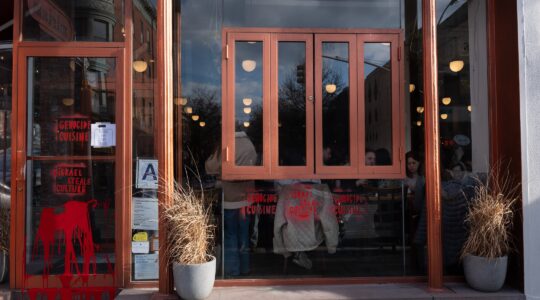Often referred to as one of the world’s oldest hatreds, anti-Semitism continues to show itself as current as the latest headlines: the U.S. Department of Education’s decision to reopen a seven-year-old bias case against Rutgers University; the flyer sent by New York State’s Democratic Party accusing gubernatorial candidate [and synagogue member] Cynthia Nixon of being silent on anti-Semitism; the ongoing controversy over allegations of anti-Semitism within England’s Labour Party; and the Anti-Defamation League’s report that indicates an increase in anti-Semitic incidents in this country.
At the center of much of this discussion is a formal definition of anti-Semitism, formulated in 2010 by the State Department’s special envoy to monitor and combat anti-Semitism and subsequently adopted by the 31 nations that constitute the International Holocaust Remembrance Alliance (IHRA). (Earlier this month, the House passed a bill that upgrades, to ambassador, the position of special envoy to monitor and combat anti-Semitism.) A bipartisan group of legislators recently introduced a bill in Congress that would formally add that definition to provisions of Title VI of the 1964 Civil Rights Act, giving Jews the same protected status as blacks, Hispanics and other ethnic minorities.
Mark Weitzman, director of government affairs for the Simon Wiesenthal Center, and chair of the IHRA Committee on Antisemitism and Holocaust Denial, closely follows trends in anti-Semitism. The Jewish Week spoke with him earlier in the month.
Q: How important in the battle against anti-Semitism is a formal definition of anti-Semitism?
A: A formal definition is extremely important on a practical level. When you see [Arab] people claiming that they can’t be anti-Semitic because they are Semites, when you see people justifying the most vicious statements about Jews by saying they are only criticizing Israel, you realize that there is confusion in many people’s minds about what anti-Semitism means. Anti-Semitism has exploded beyond national borders; to work on this issue requires a definition that also transcends borders. I was very glad to introduce and guide the Working Definition of Antisemitism through IHRA. It has now been recommended by the European Parliament, the Secretary General of the UN and is used by the State Department, making it the most important and, according to Wikipedia the most widely used definition of antisemitism in the world!
Why has anti-Semitism morphed from a feature largely of the right to one now popular among many people on the left?
That’s a little bit of a mistake in that premise; anti-Semitism has always been present on the extreme left. Circumstances today have made it easier for people to start mainstreaming anti-Semitism, the delegitimization of Israel. Anti-Semitism on the right is generally stereotyped, aimed at Jews and Judaism.
After World War II, after the horrors of the Holocaust came to light, most people thought that anti-Semitism — or the practice of openly proclaiming it — was a thing of the past. What happened, why is it making a comeback?
In the West we thought it was a thing of the past. You still had anti-Semitism coming from the communist bloc.
How is the 2018 brand of anti-Semitism different from the anti-Semitism of the Alfred Dreyfus era, of the Shoah, of the times of Communism?
There are parallels in some ways.
The Dreyfus era was an attempt to keep Jews out of the ruling elites of Europe. You can see some parallels [today] in some places like Hungary.
The Shoah [Holocaust] took that further and tried to destroy the Jewish presence in Europe totally. There, there are no parallels. What we have in 2018 is a return in some European countries of traditional nationalism with an attempt to rewrite the history of the Shoah and local collaboration [with the Nazis].
We have attacks [in some European countries] on Jewish practices such as shechita [kosher slaughter of animals] and milah [performing circumcisions].
Other [non-Jewish] groups have learned that they cannot be silent. Many [international] institutions were created at least in part in response to the Holocaust; the concepts of genocide and war crimes tribunals were reactions to the Holocaust.
Who are the main perpetrators of anti-Semitism today?
It’s a long list. radical Islam, extreme nationalists with roots on the far right, the far left that is attempting to delegitimize Israel.
For decades the opponents of anti-Semitism and racism in this country often found common cause. Then the Jewish and black communities began to find themselves at odds. Has the situation improved, is there still a large amount of anti-Semitism in parts of the African-American community?
The African-American community is not monolithic. There is a record of strong relationships, but you do have issues — you have to look at [Rev. Louis] Farrakhan [of the Nation of Islam], and the radical aspects of intersectionality.
What is the role of the Muslim/Arab world in spreading anti-Semitism?
There is clearly a level of extreme anti-Semitism in the Arab/Muslim world. And there is evidence of goodwill.
What is the best way to combat anti-Semitism on a personal and community-wide level?
It requires a commitment to stand up. We as citizens need to demand that our leaders all condemn anti-Semitism. It’s a bipartisan issue.
The New York Jewish Week brings you the stories behind the headlines, keeping you connected to Jewish life in New York. Help sustain the reporting you trust by donating today.




